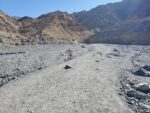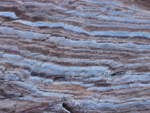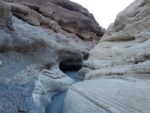Mosaic Canyon Trail Hiking Guide – Death Valley National Park
Located near the tourist destination of Stovepipe Wells in Death Valley is a popular and short one-way hike called Mosaic Canyon. Formed by an eon’s worth of violent flash floods, this canyon has been carved deep into the side of Tucki Mountain on the northern end of the Panamint Range. Although this canyon is visibly quite large, the trail will only lead into two miles of the canyon.
What hikers will find by traveling into this canyon is a wide variety of vibrant orange and red colors. Depending on the time of day and angle of the sun, at times the canyon can also be filled with soft pastel hues. Aside from the colors, Mosaic Canyon is widely known as being a narrow slot canyon. There is also the opportunity to view two dry waterfalls ranging between twenty to twenty-five feet in height. To reach the dry falls it does require a bit of rock scrambling, something that may not be for everyone (more on that below).
For those who are fascinated by geology, the walls of Mosaic Canyon will be quite a highlight. Eroded by floods over time, there are a few sections of the canyon with polished marble. The first of these large marble slabs is just a quarter of a mile into the hike from the parking area. Also along the canyon walls will be rocks from which the canyon gets its name, mosaic breccia. These finger to soft ball sized rocks will appear angular and are embedded in a natural form of cement.
On A Personal Note:
I found Mosaic Canyon to be a fun trail with quite vivid colors. There is a little rock scrambling required to get around a set of large boulders that block part of the narrows about a mile into the trail. For some people this will mark where the turnaround point is. If you have any slight bit of adventure in you, I assure you doing the scramble past the boulders really isn’t that bad. I did it with a toddler on my back in a child carrier (safely of course).
After the boulder scramble the canyon leads to two dry waterfalls. The first dry waterfall is about twenty feet in height. My wife and I did see some people that were able to climb it to carry on to the next dry fall. However, the NPS discourages climbing the dry falls to help prevent injuries. I did not feel comfortable attempting it with a toddler on my back so that was our turnaround point. I should have paid more attention to the placard at the beginning of the hike: about 180 feet before the dry fall is a foot path on the west side of the canyon wall. This path leads forty feet above the canyon floor and will bypass the dry fall and lead safely to the second fall and the end of the trail.
Looking for another hike nearby? Check out the Salt Creek Interpretive Trail on the east side of Tucki Mountain. This short trail features a creek formed by springs that gather rainfall and snowmelt from the Panamint Range.
Sources:1. N.a. “Mosaic Canyon.” Death Valley National Park. National Park Service Placard. Exhibited at Salt Creek Interpretative Trail February 2021.
- Overall Difficulty: 75%
- Overall Views: 85%
Mosaic Canyon Trail Quick Facts:
- Max Elevation: 1,611 feet.
- Elevation Gain: 679 feet.
- Estimated Distance: 4 miles.
- My Actual Distance: 2.8 miles.
- Estimated Time: 2-3 hours.
- My Time: 1 hour 19 minutes moving; 1 hour 30 minutes total.
Mosaic Canyon Trail Directions:
Mosaic Canyon Trail Pictures:
- One of the placards at the beginning of the trail.
- Pay attention to the details of the information at the beginning of the trail. We missed the bypass trail leading to the second dry fall.
- The gravel parking lot at the beginning of Mosaic Canyon.
- Leading up from the parking lot; a dry flood plain.
- One of the narrows throughout the canyon; keep an eye out for polished marble and mosaic breccia.
- Some of the polished marble throughout the canyon.
- Looking up through Mosaic Canyon.
- Mosaic Canyon Trail Hiking Guide, Death Valley National Park
- Looking out towards Death Valley.
- Some of the more narrow canyon walls.
Who Mosaic Canyon Trail Is For:
Advanced Hikers: For being a short trail this hike has a bit of scrambling and a narrow trail leading up to dry waterfalls which make this a fun trail.
Expert Hikers: Although this is short, don’t discount the colors that can be seen here or the dry falls. Pair this hike with some longer trails in the area. Otherwise, complete some of the longer hikes that this park has to offer.
It’s always a good idea to be aware of what type of hiking level you’re at.
Best Time Of Year To Hike Mosaic Canyon Trail:
Late fall to late winter is without a doubt the best time of year to hike this trail. The months near late fall or early spring can be tolerable but it is still rather warm. Once April-October comes around it is just hot. The middle of the summer is one of the hottest places on the entire planet and significant outdoor activity isn’t really recommended. Those who are sensitive to heat are advised to be out during the cooler hours of the morning or not at all.
One of the best things about visiting during the winter is seeing the view of the Panamint Range. These mountains are tall enough to catch residual weather systems coming off the Sierra Nevada. During the winter months the Panamint Range is often capped in snow and provides a nice contrast to the desert landscape. Once a decade or so enough rainfall will make its way into the valley to cause a rare superbloom with vibrant flowers.
Summer can bring about other problems besides just heat. The summer months is the monsoon season for the southwest desert. This season brings about the chance for lightning and thunderstorms. Avoid being out in the open during a thunderstorm to prevent being hit by lightning.
It’s always a good idea to check the weather before heading out on a hike.
Mosaic Canyon Trail Conditions:
This trail isn’t really maintained but it does get a lot of use. However, being that the trail follows a narrow canyon in a desert environment, it doesn’t really need any significant maintanence. The trail is very straight forward and follows the natural curve and bends of the canyon. Some spots along Mosaic Canyon are very wide and others resemble that of a slot canyon. The minor boulder scrambling and dry falls section are detailed in the “On A Personal Note” section. Beeing that this is a desert environment, keep an eye out for rattlesnakes.

















